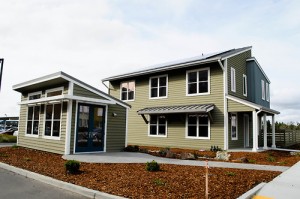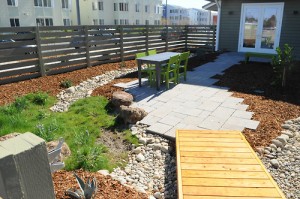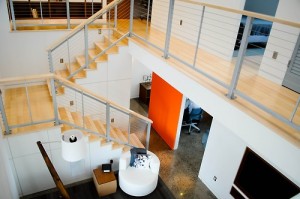Honda Smart Home opens in Davis for zero-carbon living
 Honda and the University of California, Davis, have opened the Honda Smart Home US, showcasing technologies that enable zero net energy living and transportation. The home in UC Davis West Village is capable of producing more energy on-site from renewable sources than it consumes annually, including enough energy to power a Honda Fit EV for daily commuting.
Honda and the University of California, Davis, have opened the Honda Smart Home US, showcasing technologies that enable zero net energy living and transportation. The home in UC Davis West Village is capable of producing more energy on-site from renewable sources than it consumes annually, including enough energy to power a Honda Fit EV for daily commuting.
A Honda-developed home energy management system and an energy efficient design will allow the occupants to use less than half of the energy of a similarly sized new home in the Davis area for heating, cooling and lighting. The home is also three times more water-efficient than a typical U.S. home. Watch videos about Honda Smart Home US.
Honda Smart Home, construction of which began in April 2013, will serve as a residence for a member of the UC Davis community, whose selection will soon be announced. The fully-furnished home comes equipped with a Honda Fit EV battery electric vehicle for daily transportation.
In addition to showcasing Honda’s vision for sustainable, zero-carbon living and personal mobility, the home will function as a living laboratory where the company, along with researchers from UC Davis and Pacific Gas and Electric Co. (PG&E), will evaluate new technologies and business opportunities at the intersection of housing, transportation, energy and the environment.
Honda’s environmental efforts extend beyond personal mobility to address two of the primary sources of carbon dioxide emissions: cars and homes.
Honda Smart Home fits right in at UC Davis West Village, the largest planned zero net energy housing development in the United States. Opened in 2011, West Village is home to the university’s internationally recognized research centers focused on energy efficiency, sustainability and transportation.
Sustainable features
Honda Smart Home brings together innovative technology and the latest green building concepts:
Solar photovoltaics — A 9.5kW solar photovoltaic, or PV, system mounted on the roof will generate more energy than the home and Fit EV consume on an annual basis, due in large part to the efficient design of the home. All of the energy for space heating, space cooling, ventilation, lighting, hot water, appliances and consumer loads, in addition to the transportation energy for the Honda Fit EV, is supplied by the solar panels on the home.
Electric vehicle charging — The Honda Fit EV included with the home has been modified to accept DC power directly from the home’s solar panels or stationary battery, eliminating up to half of the energy that is typically lost to heat during DC-to-AC and AC-to-DC power conversion. When the solar panels are generating electricity at full capacity, the vehicle can fully recharge in approximately two hours directly from sunlight.
Geothermal radiant heating and cooling — In homes and cars, heating and air conditioning systems consume significant amounts of energy. In the ground beneath the Honda Smart Home’s back yard, eight 20-foot-deep boreholes allow a geothermal heat pump to harness the ground’s relatively stable thermal sink to heat and cool the home’s floors and ceiling throughout the year. Researchers from UC Davis will evaluate the performance of the system to determine its adaptability to mainstream use.
Advanced lighting — The LED lighting used throughout the home is not only five times more energy efficient than conventional lighting, is is also designed to support the health and wellness of the home’s occupants. Honda worked with researchers from UC Davis’ California Lighting Technology Center to explore new circadian color control logic.
Mimicking the natural shifts in daylight that occur from morning to night, the circadian-friendly lighting design allows occupants to select lighting scenes that complement occupants’ circadian rhythms and support nighttime vision.
The amber hallway night lights, for example, provide enough light to navigate through the home in darkness without depleting a photopigment in the human eye called rhodopsin that helps people see in low-light conditions. This allows occupants to move about safely and return to sleep quickly and easily.
Exposure to bright, blue-rich light during the day helps put body and mind in an alert and energetic state, but at night, blue light can disrupt circadian sleep cycles. Therefore, Honda Smart Home minimizes the use of blue light at night.
Passive design — Honda Smart Home is designed to be extremely energy efficient by taking into account local weather conditions, sun direction and the home’s outer shell. Known as “passive design,” these techniques reduce the energy needed for heating and cooling while maintaining comfortable living conditions.
Honda Smart Home’s south-facing windows are optimized for heating and cooling, while the north-facing windows are positioned to maximize natural light and ventilation. This will keep the home naturally cool in the summer and warm in the winter. Double stud walls, cool roofing material and a fully insulated concrete slab all contribute to the home’s energy efficiency.
—UC Davis


